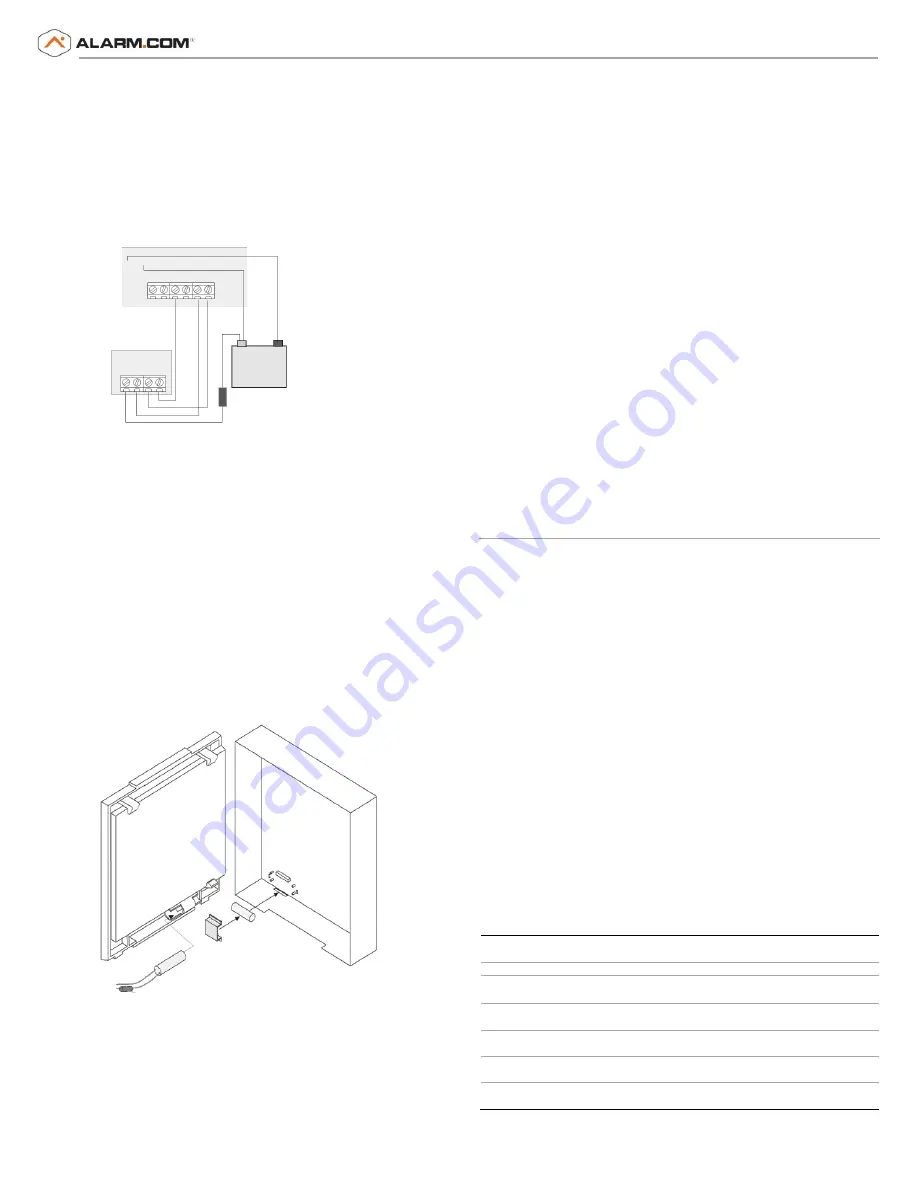
Copyright © 2015 Alarm.com
|
www.alarm.com
|
v1_2
3
Concord 4 LTE Module
|
Installation Guide
|
ADC-87-008700-112
To wire the module to the panel, do the following:
1)
Remove panel AC Power and disconnect the backup battery. This is
necessary to prevent damaging the panel or module while making
wiring connections.
2)
Wire the module to the panel bus and to the battery terminals for
power as shown in Figure
Note: The module can also be powered off the SuperBus2000 two amp
power supply (600-1019), but should not be powered directly off the panel.
Figure 5: Wiring Terminals
3)
If required, connect an input device to the module Z1 and ZCOM
terminals.
Case Tamper Switch Installation (Optional)
If the module is easily accessible, you can add case tamper detection to
activate an alarm or trouble (depending on panel programming) when
the cover is removed.
To install the tamper switch, see Figure 6 and do the following:
1. Slide the reed switch into the plastic holder on the module back plate.
2. Connect a UL Listed reed switch (with a 2 KΩ EOL resistor 01-022) to
the module zone input or to any unused hardwired input on the panel.
3. Insert the magnet into the nibs on the top cover and press the magnet
clip down over the magnet until it clicks into place into the cover.
Figure 6: Case tamper switch installation
Power Up
To power up the module and panel and start communication between
them, do the following:
1)
Verify that all wiring between the panel and module is correct.
2)
Connect the backup battery and restore AC power to the panel.
Note: Whenever the module is added or changed, you must remove panel
power and reapply it for the panel and module to communicate successfully.
3)
Enter installer program mode and turn off the “Access Code Lock”
feature (Security menu). This MUST be set to off for the system to
communicate
with Alarm.com. The module PWR LED should turn on.
After a few seconds, the module BUS and AUTO LEDs should flash to
indicate successful communication with the panel.
4)
Verify that LTE status LED L1 is not flashing any errors (see
Module
Status LEDs
on page 4). Also, verify that LED L4 is flashing an LTE
signal level of two or higher. Otherwise, relocate the module. If LED
L1 and LED L4 are not flashing, and LED L2 and LED L3 are flashing
together, the module is in PowerSave Mode and the battery needs to
be charged.
5)
Perform an installer LTE manual phone test.
At a system touchpad,
•
Enter “8” + [installer code] + “3”
•
Disarm the panel by entering “1” + [installer code] within 10
seconds of starting the phone test. Before doing the manual
phone test, the bottom red status LED should be on and the
yellow status LED should be flashing. The yellow LED will stay on
solid once the manual phone test is completed.
Note: Do not press any system touchpad buttons during the five to eight
minutes or the time will not set. During this time, the keypad will go in and
out of programming mode and will beep several times.
Gateway Status LEDs
The status LEDs, located on the left side of the module (Figure 1 on page
1) indicate the current signal and status of the Wireless Gateway
Module. The bottom red LED indicates if the module is in range and if it
is registered. The yellow and green LEDs indicate the message status.
The top LED is not used.
Red LED
On: The module is in range and registered with the network.
Off: The module is out of range and not registered with the network.
Blinks: The module is registered with the network, but out of range.
Yellow LED
On: LED on after the first message has been sent by the module and
received by Alarm.com.
Off: LED off until a message has been sent by the module.
Blinks: The first message is being sent by the module.
Green LED
Off: The LED is off as soon as Alarm.com receives a message from the
module (off most of the time).
Blinks: A message is being sent by the module.
Table 4: Status LED Condition Patterns
Condition
Number
Red
LED
Yellow
LED
Green
LED
Condition
1
Off
Off
Off
Module not powered up/not working
2
On
Off
Off
Module in range, first message not sent,
not currently sending message.
3
On
On
Off
Module in range, first message sent, not
currently sending message.
4
On
On
Blinks
Module in range, first message sent,
currently sending message.
5
On
Blinks
Blinks
Module in range, sending first message,
currently sending message.
6
Blinks
On
Blinks
Module out of range, first message sent,
currently sending message.
Concord Control Panel
+ -
12V Battery
24V
GND +12V
A B
Black Green White
Red Black
- +
10 amp fuse
Red
LTE Module
+12V A B GND
Module Back Plate
Module Cover
Magnet
Magnet Clip
Reed switch
2.0 KΩ
























